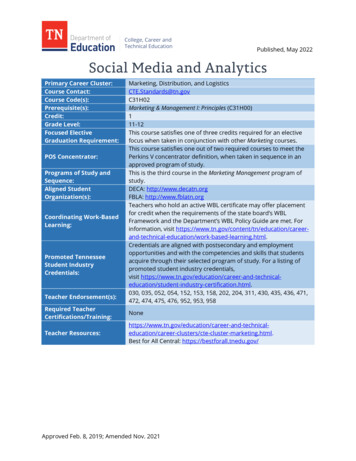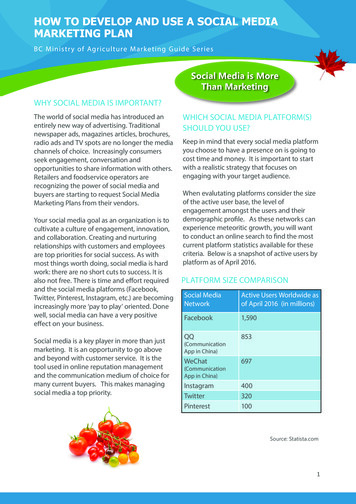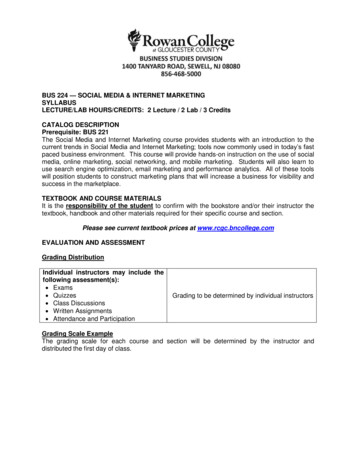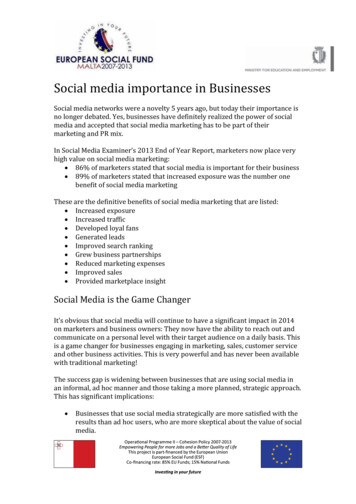
Transcription
Social Media MarketingSocial media impact on brand awareness in the case of Husqvarna Sverige's customersBachelor Thesis within Business AdministrationAuthors:Nermin KljucaninPouyan PourjanakiSaid ShahbaziTutor:Dijana BogicJönköpingMay 2012
Bachelor Thesis within Business AdministrationTitle:Social media marketing: Social media impact on brand awarenessin the case of Husqvarna Sverige's customersAuthor:Nermin Kljucanin, Pouyan Pourjanaki, Said ShahbaziTutor:Dijana BogicDate:May 18, 2012Key terms:Social media marketing, Brand awareness, Relationshipmarketing, Word-of-mouth, Husqvarna Sverige, Facebook,Twitter, Youtube, Social media channels, Viral MarketingAbstractPurpose:The purpose of this thesis is to understand how brand awarenessamong customers is created and maintained through the use ofsocial media as a marketing tool.Background:The web does not only provide people to socialize and share andreceive information among friends and family online, it is also apowerful marketing tool and marketing place where the customercan interact with other customers and firms. Social media hasmade it possible for customer to choose on their own when andwhere they want to receive information. The customers do nothave to visit a firm's homepage; they can instead interact withother customers that have experienced a specific product or brandvia the social media channels. Hence social media channels areenvironments where the customers set the rules and WOM makesor breaks the product.Method:We used a mixed method approach. To gather our empirical datawe used a questionnaire which we did send out to Facebookusers whom likes Husqvarna Sverige's page to answer abouttheir perceptions of Husqvarna and their social media activity.We did also an interview with Anna Lindman, project manager atHusqvarna.Conclusion:Social media marketing is successful when online activities,relationship marketing and brand awareness are used inconjunction. All these parts are connected to each other and haveto be fulfilled if a firm wants to be successful in social media.This will influence the customer’s purchasing behavior andcould lead to an increase of sales (Miller & Lamas, 2010). Therespondents answer from the questionnaire show that Husqvarnaneeds to be more active and participating online.
AcknowledgementsThis thesis was written during the spring of 2012. Our bachelor thesis has beenconducted as the concluding part of our bachelor of science with the major in businessadministration.Social media marketing is a relatively new area in marketing, especially in Sweden, itseemed interesting to look further into this phenomenon and that is why we chose thisfield of interest. During the process, from the start till the end, there have been manypeople involved that we would like to give special thanks to show our appreciation oftheir help. We as authors would like to express our gratitude to all the people who insome way have helped and facilitated our work and also who have supported us duringthe writing process of our bachelor thesis.First of all, we would like to thank the personnel at Husqvarna Sverige for taking theirtime and sharing their valuable knowledge and information about their company withus, as well as giving consent to the interview. We want to give special thanks to AnnaLindman, Project Manager Web Communication & Social Media at Husqvarna AB, andCecilia Kaverlén, employee at the marketing department who is responsible forHusqvarna Sweden's Facebook page, for their contributions throughout our thesis. Theirexperience and proved knowledge in this field gave us different perspectives on thesubject who worked as an excellent foundation for both our empiricism and analysis.A special thanks to our tutor Dijana Bogic from the marketing and logistic departmentat the Jönköping International Business School for her constant support, relevantcomments, and supportive feedback throughout the entire process.Last, but not least, we also would like to show our appreciation to our fellow students inour seminar group who have given us feedback, comments and suggestions throughoutthe seminar sessions. We appreciate the time and effort you all devoted to us, throughwhich our research was made possible.Finally, we must extend big heartfelt thanks to our families for their support given to usthroughout the whole process. We value their opinions more than they know and canimagine. Their motivational words when things have been difficult mean a lot for us.Thanks for all the psychological help and your support in both the ups and downs.Thank you all!Nermin Kljucanin,Pouyan Pourjanaki,Said ShahbaziJönköpingMay 2012
Table of Contents1Introduction .11.1 Background .11.2 Problem discussion .41.3 Purpose .51.4 Perspective.51.5 Delimitations.61.6 Disposition.61.7 Definitions.72Frame of reference .82.1 Investigating the literature .82.2 Brand awareness .92.3.1 Lifetime value of a customer relationship .122.4. Word-of-mouth.142.5 Social media marketing .162.6 Viral marketing.172.7 Summary of the theoretical framework .173Method .213.1 Research approach .213.1.1 Qualitative approach .213.1.3 Mixed method approach .233.2 Data collection.233.2.1 Interview .233.2.2 Questionnaire.243.2.3 Secondary data collection.253.3 Reliability and validity of data.263.3.1 Generalizability .263.3.2 Criticism of sources.26
4Empirical data .274.1 Overview of the empirical data .274.2 Structure of the answers.274.2.1 Husqvarna.274.2.2. Brand awareness.294.2.3. Social media .314.2.4 Open question.354.3 Interview with the company representative.364.3.1 Social media strategy.364.3.2 Husqvarna's use of social media creating brandawareness .375 Analysis.395.1 Analysing the empirical data .395.1.1. Husqvarna.395.1.2 Brand awareness.445.1.3 Social media .465.2. Analysing the interview with the company representative.515.2.1. Social media strategy.515.2.2. Brand awareness created by social media.526 Conclusion.547 Discussion.55References.56Appendices.61
1 IntroductionIn this section we will discuss the background of our thesis, and the problems we havebeen trying to solve. Here we also introduce the purpose as well as delimitation andstructure of our project. In the end of the chapter we define some important keywords inorder to facilitate for the reader.This thesis will be conducted using Husqvarna Sverige as an exploratory case study.Husqvarna is one of the leading companies in the outdoor power product market and asthe premium quality brand they are they want to stand for professionalism throughoutthe company. Husqvarna is currently located in over 50 countries all over the world.During the last couple of years social media has grown rapidly and companiesworldwide have started to use social media more frequently as a part of their marketingtool, no matter what market they represent. Even though if there is still a need fortraditional marketing Husqvarna Sverige are shifting more and more from traditionalmarketing towards social media marketing, but all these parts are a part of theirmarketing mix. Husqvarna knows that their customers are out there on the net and forapproximately one year ago they decided to start using social media marketing. Todaythey are primarily using Facebook, Twitter and YouTube as their social media channels,which are a part of their social media marketing. Husqvarna lack a comprehensiblestrategy that can be implemented throughout the company and they are therefore tryingto figure out which ways are successful when doing social media marketing and whichare not. (Personal communication, Anna Lindman, 2012-02-24).The fact that Husqvarna are relatively new in social media we find interesting for ourresearch due to they, like many other companies, are shifting more and more fromtraditional media towards social media. Hence we think it is a great opportunity for usto examine how a market leader as Husqvarna uses social media as a communicationand marketing tool in their daily operations, and how it affects the customers' perceptionof the brand. Therefore we find this topic interesting to further look upon it.1.1 BackgroundThe World Wide Web was introduced in 1989 and the same year Internet became aglobal network, but it was first in 2004 when Web 2.0 was developed that firms andindividuals realized the new possibilities that are present online (Hensel & Dyes, 2010).Social media has not only changed the way individuals communicate and interact witheach other, but it has also changed the communication of information for firms. Theidea of social media is that it is supposed to be a two way communication, not a oneway communication like traditional media (Ström, 2010). Compared to the traditionalmedia approach, social media marketing works differently due to the same message isdirected towards many online users, which is more efficient (Thackeray, Neiger, Hanson& McKenzie, 2008).During the last couple of years there has been a shift from traditional media towards“Web 2.0” (Thackeray, et al., 2008). The Internet was perceived as a static place during“Web 1.0”, but during the Web 2.0 the web has become more users generated and more1
flexible due to it enables the users to interact with each other. Thus Internet has becomea social medium (Eley & Tilley, 2009). According to Carlsson (2010) people todayspend more time by their computers than outside with friends, but the social need is stillthere and social media forums are a perfect place for sharing and receiving informationon the Web. Carlsson (2010) mentions further that the Web does not only providepeople to socialize and share and receive information among friends and family, it isalso a powerful marketing tool and marketing place where the customer can interactwith other customers and firms. Social media has made it possible for customer tochoose on their own when and where they want to receive information. The customersdo not have to visit a firm's homepage; they can instead interact with other customersthat have experienced a specific product or brand via the social media channels. Thussocial media channels are intangible environments where the customers set the rules andword-of-mouth makes or breaks the product (Carlsson, 2010).Word-of-mouth marketing occurs when the customer has positively been commendedby the company and this can lead to the customer having closer ties to the firm. Whenthe customer has a strong relationship with the firm the likelihood of the customerspreading its experience and recommending the firm to his friends in form of word-ofmouth promotion is increased, this in turn help the growth of the company and theircustomer base (Grönroos, 2007). Word-of-mouth has transformed with the introductionof the Internet, it has gone from intimate word-of-mouth towards reaching hundreds andthousands of people online. The reason why word-of-mouth is a great marketing tool isdue to its high credibility and the fact that all people have a need for social mediainteractions (Gummesson, 2008). The main weakness with word-of-mouth marketing isthat it cannot be controlled by the firm and if negative word-of-mouth information isleaked it will spread like fire, mainly between customers. Thus the strength of word-ofmouth marketing is also its weakness (Carlsson, 2010).Most of the traditional marketing methods are rather ineffective compared to usingsocial media where online marketing has become more profitable (Williams, 2009). Fora firm to be profitable in their marketing activities they should use traditional marketingand social media in conjunction with each other (Hensel & Dyes, 2010). In order for afirm to be successful in social media marketing, which is a quite new and efficient wayfor the firms to interact with their customers, it requires a lot of work from themarketers because the social media channels have to be maintained and made in a userfriendly way. Another problem is that more firms are using social media marketing eventhough they lack knowledge how to use it. This is an important aspect that the firmshave to be aware of, because if the customers are not satisfied with the firm or theirproducts or services this could be disastrous for the firm due to it could end up innegative information that will be spread over Internet from customers that are not afraidto express their thoughts and experiences of the brand (Carlsson, 2010).Firms should contentiously try to find new ways to market themselves and reach out tothe customers, since customers prefer to be informed by other persons than by firms, thefirms should try to involve customer influencers and discover ways how to engage themin order to create brand advocates that will do word-of-mouth marketing for the firm tothe customers. Compared to previous marketing tools social media is providing userswith an own voice and here they are not passive consumers as in their previous brandrelationships, but instead they are active members of the brand community (Miller &Lamas, 2010). Compared to traditional media, in social media the customers have the2
control and social media channels are intangible environments where it is possible forone person to communicate with hundreds and thousands of people about a specificproduct or company (Mangold & Faulds, 2009). Using traditional media a dissatisfiedperson can tell ten people while using social media one person can tell millions ofpeople and that over a night (Gillin, 2007). This is illustrated in the figure below whichcan be seen in figure 1.2. Carlsson (2010) mentions that no firm can control what is saidabout the firm and its products and services, but the firm can try to influence thecustomer's image of the firm. By keeping the negative opinions to its minimum on thedifferent social media channels and creating delighted and interested customers theword-of-mouth is more likely to be positive (Carlsson, 2010).Figure 1.2: Illustration of the WOM influence on the different social media networksIf a firm wants to be successful in social media marketing they cannot neglect the vitalimportance relationships have when it comes to interaction between the firm and thecustomer, where it facilitates the two-way exchange of information between the twoparties involved (Grönroos, 2007). The technological growth has facilitated the processof interaction between the firm and the customer and it is increasingly important forfirms to become more adaptable and flexible in the modern society that is constantlychanging. For the company to manage all this, the company needs to enhance learningskills from their consumers, and this can be done through interaction with their targetaudience (Castells, 2000). Swedowsky (2009) mentions that the value that is existing onsocial media networks cannot be ignored, particularly since the scope of social media isincrementally increasing (Stephen & Toubia, 2010) and in this new era, the era of socialmedia, it is the customers that have the control and more access to information whichhas enabled them to have greater control than ever before (Mangold & Faulds, 2009).1.2 Problem discussion3
Social media marketing has emerged as the new way of doing marketing where thecustomers are no longer passive consumers as they were in the previous marketingforms, but rather here they are active participants; this is mainly due to the interactionpossibilities that exist on Internet (Miller & Lammas, 2010). The resources firms areinvesting on social media are incrementally increasing and firms are slowly shiftingfrom a traditional way of doing marketing towards a more interactive way (Thackeray,et al., 2008). When it comes to social media firms should focus more on creating longterm relations with their customers and be active online, rather than on deliveringmessages and marketing different content (Grönroos, 2007). Swedowsky (2009)mentions that if the firms manage to create strong brand awareness among theircustomers they will improve the likelihood of them do positive word-of-mouthpromotion for the firm among their friends and family. This was the way before the startof social media and the way has developed further (Swedowsky, 2009). Grönroos(2007) mentions that Word-of-mouth promotion is the objective of social mediamarketing and the result of a successfully maintained relationship between the firm andtheir customers. Positive word-of-mouth results in improved brand awareness amongcurrent and potential customers, with an increased likelihood of them purchasing thefirm's products (Grönroos, 2007). Carlsson (2010) mentions that the main obstacle forfirms is that they cannot control word-of-mouth marketing, but rather it is the customersthat have the control. Hence it is important that firms are successful in their interactionswith their customers in order to keep the negative opinions to a minimum (Carlsson,2010).If firms are successful in their social media marketing they will gain a competitiveadvantage over their market competitors, but firms have to be cautious due to they donot have a monopoly on the marketing tools, instead it is being shared with thecustomers whom has the majority of the control and can choose on their own accordwhere and how to reach out to the firm (Qualman, 2010). Carlsson (2010) mentions thatthere is a difference between what the firms tell their customers and what other peopleare saying about the firm, therefore people usually tend to trust what is recommendedby their friends and not the marketers. Swedowsky (2009) mentions that no matter howand why the firms tend to approach the customers to buy their products the purchasingdecision has always been distinctive, mainly due to it is a social endeavor. Therefore isit necessary that retailers get involved and pay attention because people tend beforemaking a purchase to consult somebody that they have trust in, mainly family membersand friends (Swedowsky, 2009). Thus, if a firm has been successful in their interactionswith their customers it can result in stronger brand awareness which has an impact onthe customers' willingness to purchase the firm's products (Grönroos, 2007). Thestronger the customer's brand awareness is, the more dominant will the firm's brand bebecause the customer will not look for other alternatives on the market, thus improvingthe customer's loyalty to the firm (Kotler & Armstrong, 2004).In order for a firm to gain long-term benefits from using social media they should usesocial media and relationship marketing concurrently due to here the customer is seen asa “co-creator”, compared to the old and traditional view where the customer is only atarget to sell to (Miller & Lamas 2010). When firms use social media they should haveproper branding and customer service strategies that are needed for their overall socialmarketing strategy where participating in online conversation about the brand are vitalfor the firms' success online (Williams, 2009). Hence, if firms want to be successful in4
their marketing activities they should listen to their customers, share information withthem and build relationships in order to gain mutual trust so that they can influence theircustomers' behavior (Miller & Lamas 2010). Thus, social media facilitates the processesof interaction, relationship and value (Harridge-March & Quinton, 2009).1.3 PurposeThe purpose of our thesis is to understand how brand awareness among customers iscreated and maintained through the use of social media as a marketing tool.In order for us to fulfill our purpose we will base our research on following questions:Research question 1: How should social media is used when firms do marketing inorder to increase the customers' loyalty and willingness to do word-of-mouth for thefirm? We will look into what the respondents’ think, what the theory is suggesting aboutthis topic and lastly, we will look into how Husqvarna are using social media marketingin their daily operations.Research question 2: What influence has social media on the customer's perception ofthe brand and how does it affect the customer's behavior? In order for us to answer thisquestion we will look how Husqvarna's uses their social media strategy, what therespondents think about the brand and we will also look into what the theory says abouthow social media marketing should be used in order to improve the customer'sperception of the brand.1.4 PerspectiveIn order to answer our purpose we will look at it from two perspectives: 1) Consumerperspective, which is our primary focus. Here the respondent's will give their perceptionon the Husqvarna brand, their own use of social media and their attitudes towardsHusqvarna's usage of social media activities. 2) Company perspective, due to it is anexploratory case study we will also focus on Husqvarna’s thoughts on their own usageof social media channels and how they want social media marketing to affect thecustomer's perception of the brand.We will conduct our research focusing on the theoretical aspect where we will useHusqvarna Sverige as an exploratory case. The objective with our thesis is to investigatewhat and how Husqvarna Sverige is doing to create and increase the brand awarenessamong their customers using social media marketing. Worth emphasizing is that thefocus lies primarily on the customer perspective and what impact social mediamarketing has on the customer brand awareness. We find the social media marketingtopic interesting to investigate due to it is not so illuminated, especially for Swedishfirms that are relatively new in this type of area. It is an area that is actual and popularin today's information society, but with the future still unclear and with a lot of room forfurther improvement.5
1.5 DelimitationsThe project group will focus their project on social media marketing and only look atthe major social media channels in form of Facebook, Twitter and YouTube. Hence wewill not emphasize our research on traditional media marketing where there already hasbeen conducted a lot of research throughout the years.We will focus our project only on Husqvarna Sverige and not on the other countries thatare a part of the Husqvarna Group which are active on the different social mediachannels. In this paper we will only use the term “Husqvarna”, “Husqvarna Sweden”and “Husqvarna AB”. AB is a Swedish abbreviation for the English term limitedcompany. These words we will use instead of the actual name “Husqvarna Sverige” inorder to facilitate for our international readers.To collect our empirical data we will interview employees that work in HusqvarnaSweden and upload a questionnaire enabling the customers that like HusqvarnaSweden's page on Facebook to answer in order for us see their thoughts Husqvarna AB'sbrand and social media activities. In the questionnaire we will focus primarily on thecustomers' and employees' at Husqvarna AB their perception of the Husqvarna brand.The project group will not give any suggestions concerning Husqvarna Sweden’s layouton the different social media communities, or give advices on how to make onlinecommercials, and we will not give any marketing suggestions concerning the activitieson their different marketing channels.1.6 DispositionChapter2. Theoretical Background3. Method and implementation4. Empirical data5. Analysis6. Discussion and conclusionsContentHere we bring up theories that are relatedto the project's purpose which will give thereader an overall understanding of the topicIn this chapter the group describes whichmethodology has been used and how thecollection of the empirical work has beenundertaken to realize the projectHere we will bring the respondent's viewon the Husqvarna brand, their social mediaactivities and field of improvement that wereceived from the online questionnaire.Here we will analyze the results of ourempirical findings, linking it to the theoryIn this part the group gives their view onthe information gathered and suggestionsfor further improvement that have beenidentified will be brought up.6
1.7 DefinitionsTraditional media:Traditional media is type of media such as newspapers, television, radio, magazines,newsletters and other print publications (Hadenius, Lennart & Wadbring, 2008).Social media:“Social media is any kind of information we share with our social network using socialnetworking websites or services”. (Eley & Tilley, 2009, p. 78).Relationship Marketing:Relationship marketing can be described as a information-driven, interactive and moreconsumer-focused marketing if compared to other types of marketing (Falkheimer &Heide, 2007).Viral marketing:Viral marketing is a type of marketing based on online word-of-mouth where the firmsare trying to spread a message through a photo or video clip, where the strategy isshaped that the person will forward it to their friends (Haenlein & Michael, 2009).Word-of-mouth:Word-of-mouth occurs when the customer has positively been commended by thecompany. This means that, it leads to the formation of closer ties to the company. Thismeans that the client is spreading its experience and would recommend it to others,which in turn helps in growth of the company (Grönroos, 2007).YouTube:YouTube was founded in 2005 and is a famous website for entertainment where onecan, in effective way spread information through the use of video, audio and text toworld (www.youtube.com).Facebook:Facebook is a social website where different users with different backgrounds ofdifferent ages can communicate with their friends (www.facebook.com).Twitter:Twitter is an online social communication website that allows its users to be able towrite what they want to whomever they want with max 140 characters(www.twitter.com).7
2Frame of referenceIn this chapter we will bring up the theoretical concepts from previous research insocial media marketing and also bring up relevant theoretical aspects that we find isappropriate in this field in order for us to conduct our research.2.1 Investigating the literatureWe chose to do an analysis on the literature that has been conducted in the chosen fieldof interest. This due to we wanted to complement the previous research about how firmscan use social media marketing in order to increase the brand awareness among theircustomers and thus have theories that can help us fulfill the purpose with our research.Besides social media marketing and brand awareness we decided to write aboutrelationship marketing that is interrelated with social media marketing. Word-of-mouthis another phenomenon that is brought up in our theoretical investigation due to word
Bachelor Thesis within Business Administration Title: Social media marketing: Social media impact on brand awareness in the case of Husqvarna Sverige's customers Author: Nermin Kljucanin, Pouyan Pourjanaki, Said Shahbazi Tutor: Dijana Bogic Date: May 18, 2012 Key terms: Social media marketing, Brand awareness, Relationship marketing, Word-of-mouth, Husqvarna Sverige, Facebook,










